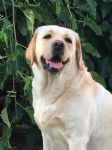The Labrador Retriever
BREED STANDARD
What it is a breed standard or why it is important?
A breed standard is a set of guidelines which describe the ideal characteristics, temperament, and appearance of a breed and ensures that the breed is fit for function with soundness essential.
It is an important "blueprint" for all breeders to follow to ensure they produce dogs which fit the standard. That is dogs which are the same, and clearly identified as the breed.
For Labradors we specifically look for head, coat, tail. A good head that you know straight away the dog is a labrador, a dense undercoat providing waterproofing when swimming, and a strong otter tail, well covered with coat tapering to the end.
Have a read of the further details below to assist your understanding of what we try to acheive in breeding these wonderful dogs.
Group 3 (Gundogs) - The Labrador Retriever
Taken from the ANK site https://ankc.org.au/Breed/Detail/7
"A breed standard is the guideline which describes the ideal characteristics, temperament, and appearance of a breed and ensures that the breed is fit for function with soundness essential. Breeders and judges should at all times be mindful of features which could be detrimental in any way to the health, welfare or soundness of this breed."
-
General Appearance:
Strongly built, short coupled, very active; broad in skull; broad and deep through chest and ribs; broad and strong over loins and hindquarters.
-
Characteristics:
Good tempered, very agile (which precludes excessive body weight or excessive substance). Excellent nose, soft mouth, keen love of water. Adaptable, devoted companion.
-
Temperament:
Intelligent, keen and biddable, with a strong will to please. Kindly nature, with no trace of aggression or undue shyness.
-
Head And Skull:
Skull broad with defined stop; clean cut without fleshy cheeks. Jaws of medium length, powerful not snipy. Nose wide, nostrils well-developed.
-
Eyes:
Medium size, expressing intelligence and good temper; brown or hazel.
-
Ears:
Not large or heavy, hanging close to head and set rather far back.
-
Mouth:
Jaws and teeth strong with a perfect, regular and complete scissor bite, i.e. Upper teeth closely overlapping lower teeth and set square to the jaws.
-
Neck:
Clean, strong, powerful, set into well placed shoulders.
-
Forequarters:
Shoulders long and well laid back, with upper arm of near equal length, placing legs well under body. Forelegs well boned and straight from elbow to ground when viewed from either front or side.
-
Body:
Chest of good width and depth, with well sprung barrel ribs - this effect not to be produced by carrying excessive weight. Level topline. Loins wide, short-coupled and strong.
-
Hindquarters:
Well developed, not sloping to tail; well turned stifle. Hocks well let down, cowhocks highly undesirable.
-
Feet:
Round, compact; well arched toes and well developed pads
-
Tail:
Distinctive feature, very thick towards base, gradually tapering towards tip, medium length, free from feathering, but clothed thickly all round with short, thick, dense coat, thus giving 'rounded' appearance described as 'Otter' tail.
May be carried gaily but should not curl over back.
-
Gait/Movement:
Free, covering adequate ground; straight and true in front and rear.
-
Coat:
Distinctive feature, short dense without wave or feathering, giving fairly hard feel to the touch; weather resistant undercoat.
-
Colour:
The only correct colours are wholly black, yellow or liver/chocolate. Yellows range from light cream to red fox. Small white spot on chest and the rear of front pasterns permissible.
-
Sizes:
Ideal height at withers:
Dogs 56 - 57 cms (22-22.5 ins)
Bitches 55 - 56 cms (21.5 - 22 ins) -
Faults:
Any departure from the foregoing points should be considered a fault and the seriousness with which the fault should be regarded should be in exact proportion to its degree and its effect upon the health and welfare of the dog, and on the dog’s ability to perform its traditional work.
-
Notes:
Male animals should have two apparently normal testicles fully descended into the scrotum.
